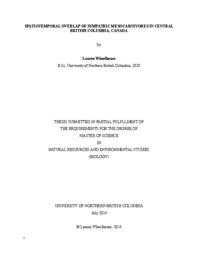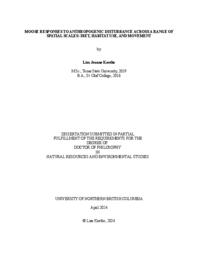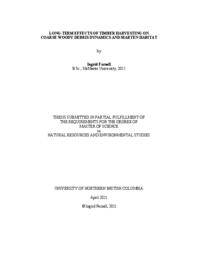Hodder, Dexter
Person Preferred Name
Dexter Hodder
Related Works
Content type
Digital Document
Origin Information
Content type
Digital Document
Description / Synopsis
Habitat loss and climate change are two of the leading causes of the global decline of biodiversity. Declines in the abundance of moose (Alces americanus) in British Columbia, Canada, in the 2000s were hypothesized to result from an interaction between a severe climate-induced insect outbreak and resulting increases in salvage harvest of affected forests. I investigated the behavioral and distributional responses of moose to forest harvesting disturbance across a range of spatial scales and tested the use of N-mixture models and camera trap data to estimate population abundance. At a fine spatial scale, I used microhistological analysis of moose fecal samples to assess the effects of logging on the diet of moose. In areas with greater intensities of forest harvesting, moose consumed fewer forbs, shrubs, and fir trees, and their diet was more diverse. These dietary responses were consistent with the Niche Expansion Hypothesis, which predicted that a generalist herbivore would eat a greater diversity of plants to compensate for decreased availability or quality of preferred forage. I used LiDAR and GPScollar data to test hypotheses that explained the use of horizontal and vertical cover by moose. Risk of predation and hunting (Direct Mortality Hypothesis) was the primary factor that influenced the use of cover. Moose used different forest structures, ranging from open to closed, depending on the threat (predation or hunting) and their response was modulated by maternal status. At a coarser spatial scale, I assessed a suite of hypotheses concerning the causes of partial migration, effects of migration on habitat used, and fitness effects of migration. Wildfire disturbance in the winter range was the primary driver of migration and most migratory moose experienced less wildfire disturbance after leaving their winter range. Migrants displaying specific movement tactics (e.g., distance and timing of migratory movements) experienced increased probability of parturition and neonate survival. Migration exposed moose to increased risk of predation but residents were more vulnerable to health-related causes of mortality. While migration provided some moose with fitness benefits, it did not fully mitigate the amount of wildfire disturbance in the summer range, particularly after severe wildfire seasons. Finally, I tested the sensitivity of estimates of population abundance produced by N-mixture models parameterized with camera trap data to ecological conditions, spatial scale of covariates, the potential for temporally non-independent detections, and model choice based on parsimony. Nmixture models produced accurate and reasonably precise estimates of abundance of moose and were robust to model formulation, the spatial scale of associated covariates, and the criteria used to define independent detection. However, I recommend avoiding measures of parsimony for selecting the model or models to generate a population estimate. In total, the results of my dissertation suggest that land management and forest harvest should maintain forest communities that vary in structure and composition. In particular, large-scale disturbance can alter the diet of moose, expose maternal moose to increased risk of mortality, and, in the case of wildfire, it could lead to a decline in migratory behaviors and populations.
Origin Information
Content type
Digital Document
Description / Synopsis
In response to the exclusion of Indigenous people from natural resources management, the Canadian federal government announced that they would provide $25 million over four years to support the development of Indigenous Guardians programs across Canada. The program was promised to “provide Indigenous Peoples with greater opportunity to exercise responsibility in stewardship of their traditional lands, waters and ice” (Government of Canada 2020). I used a case study approach to explore the role of this funding to support Indigenous communities in their Guardians initiatives. I facilitated semi-structured interviews with staff from five Indigenous Guardians programs from BC and Manitoba, Canada. Participants suggested that the federal pilot program was a step in the right direction to support environmental stewardship initiatives led by Indigenous governments or communities. In particular, this program was successful in increasing monitoring of the land, collaboration with like-minded groups, and facilitating the education of youth by community Elders.
Origin Information
Content type
Digital Document
Description / Synopsis
At a long-term experimental trial in northern British Columbia, Canada, I analysed the impact of varying amounts of timber retention: 0% (clearcut), 40%, 70%, 100% (unharvested) on CWD volume, decay class, and inputs from windthrow over 27 years. I used attributes (diameter, length, decay class, and height above the ground) known to be favourable to marten to create an index for assessing the impact of harvesting intensity on CWD habitat features. I then used airborne laser scanning (ALS) to predict CWD volume, habitat value, and piece attributes over the landscape. Stands with 70% retention had CWD attributes that resulted in CWD habitat features similar to unharvested stands. Clearcuts contained pieces that were smaller, more decayed, and closer to the ground, which contributed less valuable habitat, compared to stands with higher retention. Windthrown trees were the majority of CWD inputs and volume change was positively related to percent retention.
Origin Information




